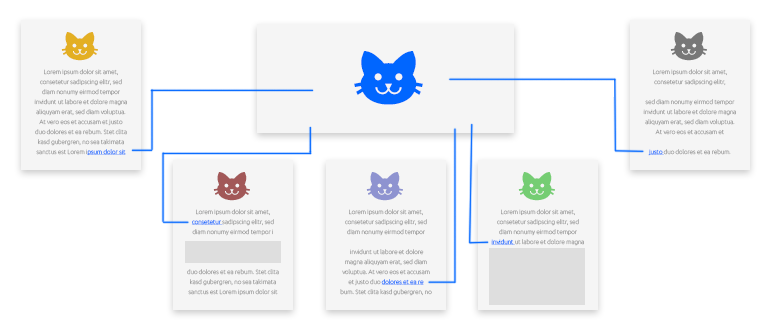Slowly but surely, SEOs are learning that high value content is just as important as technical on-page SEO when it comes to online success. High value content consists of text and other media such as images, videos, infographics and other elements. If you want to rank highly on Google, it’s vital to offer the reader genuine value.
When doing this however, it’s easy to end up producing several articles on the same topic on the same domain. Let’s say we’re writing about cats, for instance …

Here we have five articles about cats. How is Google supposed to know which is the most important? First, the search engine tests user signals from each URL, ranking each cat article higher at different times to see how they perform. Google can then test how users behave and respond when clicking on each article.
User signals
Google tests a number of different user signals. One figure which ranks highly is the so-called bounce rate – the number of users who return immediately back to Google compared to the total number of clicks on a snippet. Length of stay is also important. If a page contains a lot of content but users don’t tend to stay long, Google can conclude that the content doesn’t satisfy the user’s needs. Of course, this is no exact science. Say a user is looking for XOVI’s telephone number, googles it and lands straight on our contact page. Of course, they won’t hang around long – but does make the website bad? No – it means they found what they needed straight away!
The problem with Google’s testing process
When it comes to SEO, we’re all striving for top rankings – ideally top spot on page one. But when Google finds several similar texts and first has to test them all for relevance, it’s not possible to generate constant rankings or identify a steady development, since different URLs rank at different stages of the process. This is called keyword cannibalism – by having several different pages on the same topic, we become our own competition.
So what can I do?
The key is to focus your keyword strategy and optimize different URLs for different sub-topics and keywords as much as possible. Let’s take our cats topic again. Clearly, the topic of cats can be approached from many different angles (purchase, care, food, health, toys, etc) – and all are important if we are to provide the user with comprehensive information. Either we build one huge page which covers all different aspects or we structure a domain logically, connecting all the sub-topics with internal links and individual meta-data.
Optical example:

As we can see from the graphic above, the central element is a general page about cats. It might contain basic information about different breeds and other basics. For more detail on a particular topic, there are links to additional landing pages where specific aspects are dealt with in more detail. All are relevant to cats – on their own, they mean little.
Advantages of this approach:
- Only one title and description per URL. This means a more exact focus for meta-data and more relevance in Google. For such a large site with so many sub-topics, it’s impossible to fit all your relevant keywords into one title and description.
- Each URL gets its own unique meta-data – which is good news for search engines.
- Internal links from sub-pages to the home strengthen the domain. Google can identify a clear, logical structure which will enable a generic keyword such as “cats” to rank higher.
- Not all texts on the domain are optimized for the word “cats” – but rather for different but related terms which are all important in their own right. If a user is looking for tips on cat food, they would rather see a ranking for the sub-page than the main, general page, where they would be forced to take a further step and identify the relevant sub-page.
If you already have several pages which deal with a similar sub-topic, merge them. There’s no need to have separate pages on “fresh cat food” and “dry cat food” when you can just have one, much stronger page on “cat food.” Don’t forget to redirect the page you are deleting with a 301-redirect. You might also have backlinks leading to the old URL, so it’s important to tell the search engine where the content can now be found.
Conclusion
Beware keyword cannibalism! Don’t become your own competitor in the online market place by having multiple pages competing over the same keywords. Conduct a thorough keyword analysis and structure your content logically. There’s no need to build a landing page for every keyword – topic areas can be merged together and linked. This process supports the parent, umbrella page from which sub-pages can be linked. The main page should offer just enough information on a sub-topic to convince the reader to click further.
